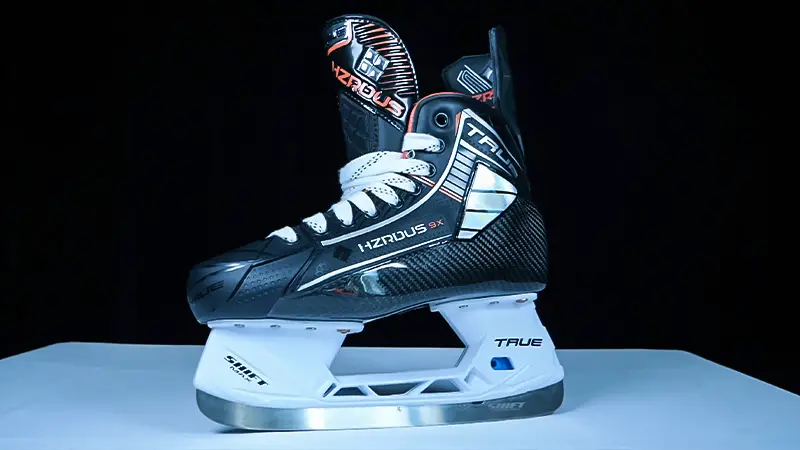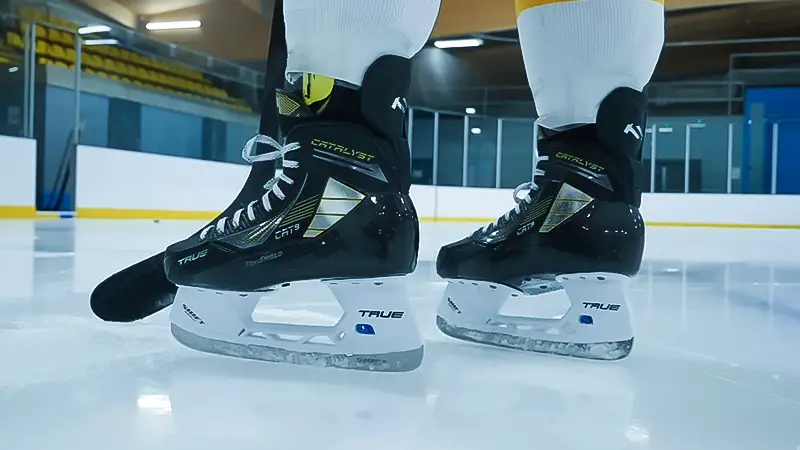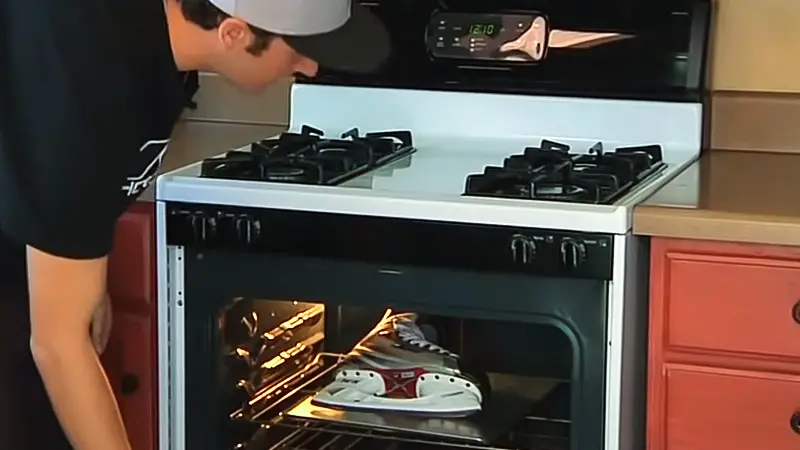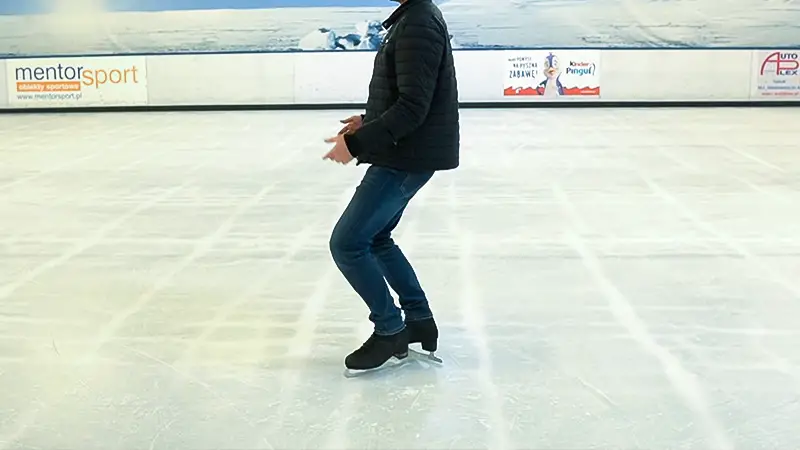For avid hockey players, having well-fitted skates is not just a matter of comfort; it’s a performance essential. The ability to glide effortlessly across the ice, change direction with precision, and maintain stability in high-intensity games depends significantly on the fit of your hockey skates.
But what if your skates don’t feel quite right or your feet have changed over time? That’s where the concept of rebaking hockey skates comes into play.
In this blog post, we’re delving into the fascinating world of rebaking hockey skates. We’ll explore the question ‘Can You Rebake Hockey Skates?’ and, why players consider it, and the do’s and don’ts of this customization process.
Whether you’re a seasoned pro or just starting your hockey journey, understanding the intricacies of rebaking can help you optimize your skating experience and, ultimately, elevate your game. Stay focused.

What Is Rebaking Hockey Skate?
Rebaking hockey skates is a process of customizing the fit and performance of a player’s ice hockey skates.
Skates are initially manufactured with a generic mold, but not all feet are the same. To enhance comfort and optimize performance, players can undergo the rebaking process.
Here’s How It Works
Heating
Skates are placed in a specialized oven to soften the boot’s materials without damaging them.
Fitting
While still warm, the player puts on the skates. The heat allows the boot to mold to the unique shape of the foot.
Cooling
The skates cool down, retaining the newly formed shape. Rebaking helps eliminate pressure points, enhances stability, and maximizes energy transfer.
It’s a common practice among hockey players looking to improve their agility and minimize discomfort during games, ensuring that their skates become an extension of their feet.
Can You Rebake Hockey Skate?
Yes, I hope so with an expert’s help maybe. Hockey players can rebake their hockey skates, but it’s typically done by a trained professional at a skate shop or pro shop.
While the process involves heating the skates to reshape them, it requires specialized equipment and expertise to ensure the skates are properly heated and molded without damaging them.
Here’s why it’s usually not recommended for players to rebake their own skates:
Temperature Control
Achieving the right temperature and even heating throughout the skate is crucial. Professionals have the necessary equipment to ensure precise temperature control, which is difficult to replicate at home.
Skill and Experience
Professional skate technicians have experience in assessing a player’s fit and addressing specific comfort or performance issues. They can make adjustments and recommendations based on their expertise.
Risk of Damage
Applying too much heat or uneven heat distribution can damage the skates, affecting their structural integrity. Professionals know how to minimize this risk.
While players can try to make small adjustments at home, such as using a heat gun to soften specific areas for minor tweaks, it’s generally advisable to consult a qualified skate technician for major adjustments or a full rebake to ensure the best fit and performance.
Why Do Players Rebake Ice Hockey Skates?

Ice hockey players rebake their skates for several important reasons:
Customized Fit
Hockey skates are typically manufactured with a generic fit. Players have different foot shapes and sizes, and rebaking allows them to mold the boot to their unique foot contours. This results in a more comfortable and personalized fit.
Reducing Discomfort
Skates that don’t fit properly can cause discomfort and even painful pressure points on the feet. Rebaking can help alleviate these issues by adjusting the boot to better match the player’s foot shape, reducing discomfort during games.
Enhanced Performance
A well-fitted skate can improve a player’s performance. It allows for better control over the skates and the ability to maximize power and agility on the ice. A customized fit can also improve balance and stability.
Optimizing Energy Transfer
Properly fitted skates ensure that the player’s energy is efficiently transferred to the ice, resulting in improved speed and responsiveness. This is essential for maintaining a competitive edge in the fast-paced game of hockey.
Accommodating Foot Changes
Over time, a player’s feet may change due to growth, injury, or other factors. Rebaking allows skates to be adjusted to accommodate these changes, extending the life of the skates and avoiding the need for constant replacements.
Injury Prevention
Ill-fitting skates can contribute to foot and ankle injuries. Rebaking can help reduce the risk of injuries by ensuring a snug and supportive fit that minimizes movement within the boot.
Comfort During Long Games or Practices
Hockey players spend extended periods on the ice during games and practices. Having well-fitted skates can make these sessions more comfortable and reduce the risk of blisters and discomfort.
Players rebake their ice hockey skates to achieve a customized fit that enhances comfort, performance, and injury prevention, ultimately allowing them to excel on the ice.
How To Rebake Your Ice Hockey Skates?

Rebaking ice hockey skates is a process best performed by a trained professional at a skate shop or pro shop. However, if you have the necessary equipment and expertise, here are the general steps for rebaking your ice hockey skates:
Materials and Equipment You’ll Need
- Skate oven or heat gun.
- Skate baking gloves.
- Skate fitting tools (if needed).
- A clean towel or skate sock.
Steps to Rebake Your Ice Hockey Skates
Prepare the Oven
If you have a skate oven, preheat it to the recommended temperature specified by your skate manufacturer. If you’re using a heat gun, set it to the appropriate temperature, usually around 175-200°F (80-93°C).
Remove Skate Insoles and Laces
Take out the insoles and loosen the skate laces. This ensures even heating and allows the boot to conform more easily to your foot.
Heat the Skates
Place the skates in the oven or use the heat gun to warm the skate-compatible boot. Make sure not to overheat, as this can damage the materials.
Wear Skate Baking Gloves
While the skates are still warm, put on skate-baking gloves. These gloves will protect your hands from the heat and allow you to handle the hot skates.
Put on Skates
Carefully put on the skates while they are still warm. Lace them up snugly to your desired tightness. Be cautious not to overtighten as the skate will mold to this shape.
Stand and Mold
Stand up and distribute your weight evenly on both skates. Flex your knees and ankles to help the boot conform to your foot shape. Hold this position for several minutes.
Cool Down
Allow the skates to cool while you’re wearing them. This cooling process sets the boot shape. You can speed up the cooling process by placing the skates near a fan or in front of a cold air source.
Remove Skates
Once the skates have fully cooled, carefully remove them.
Replace Insoles and Laces
Put the insoles back in place and tighten the laces to your preferred fit.
Test and Adjust
After rebaking, it’s a good idea to skate briefly to ensure the fit is comfortable and meets your performance needs. If necessary, make minor adjustments.
Remember that rebaking should be done with caution, and it’s always a good idea to consult with a professional skate technician if you’re uncertain about the process or if your skates require significant adjustments.
Mistakes to Avoid While Rebaking Hockey Skates

Rebaking hockey skates is a delicate process that can greatly enhance comfort and performance when done correctly. However, there are several mistakes you should avoid to prevent damaging your skates or compromising their fit. Here are eight important points to consider:
Overheating
One of the most critical mistakes to avoid is overheating your skates. Excessive heat can damage the boot’s materials, causing them to lose their structural integrity or even melt. Always follow the manufacturer’s recommended temperature guidelines for rebaking.
Uneven Heating
Inconsistent heating can result in uneven molding and lead to discomfort or performance issues. Ensure that the heat source evenly warms the entire boot, especially if you’re using a heat gun. Rotate the skate to achieve uniform heating.
Overtightening Laces
While wearing your skates during the molding process, avoid overtightening the laces. Pulling the laces too tightly can create pressure points and distort the fit. Lace them snugly but not excessively tight.
Skipping the Gloves
Skate baking gloves are designed to protect your hands from the intense heat and are essential for handling the hot skates during the process. Failing to wear them can result in burns or discomfort.
Neglecting the Cooling Phase
Allowing the skates to cool down is a crucial step in the rebaking process. Rushing this phase can lead to improperly set boot shapes. Ensure that the skates cool down completely before removing them.
Skipping Insole Removal
Removing the insoles from your skates is essential for even heat distribution and optimal molding. Leaving them in can create pockets of excess heat, potentially damaging the insoles and preventing a proper fit.
Not Seeking Professional Help
If you’re unsure about rebaking or have limited experience, it’s best to consult a professional skate technician. They have the expertise and equipment to ensure a successful rebake without risking damage to your skates.
Ignoring the Manufacturer’s Instructions
Always follow the specific rebaking instructions provided by your skate manufacturer. Different skate models may have slightly different requirements, and deviating from these guidelines can lead to poor results or damage.
Rebaking hockey skates is a skill-sensitive process that requires attention to detail and adherence to guidelines.
FAQs
Can I rebake my hockey skates at home?
Rebaking hockey skates is best done by a professional with the right equipment. Attempting it at home without experience can lead to damaged skates or an improper fit. Seek a qualified skate technician for reliable results.
How often should I consider rebaking my hockey skates?
The frequency of rebaking depends on factors like foot growth, discomfort, or performance issues. Generally, players might rebake skates every 1-2 seasons or as their needs change.
Is rebaking suitable for all types of hockey skates?
Rebaking is most effective for higher-end hockey skates with heat-moldable materials. Basic entry-level skates may not have the same level of customization, so it’s important to check with the manufacturer’s guidelines.
Can rebaking hockey skates fix any fit issues?
While rebaking can address many fitness-related problems, it may not be a cure-all. Severe fit issues may require professional assessment and modifications beyond the rebaking process.
Are there any risks involved in rebaking hockey skates?
Yes, there are risks if done incorrectly, including damage to the skates or creating uncomfortable pressure points. Consult a professional to minimize these risks and ensure a successful rebake tailored to your needs.
Wrapping Up
Rebaking hockey skates isn’t a mere fashion statement; it’s a practical solution for achieving a comfortable and high-performing fit. We’ve unraveled the mysteries surrounding the process, from the reasons players choose to rebake their skates to the crucial do’s and don’ts to ensure success.
Remember, while rebaking can work wonders, it’s not a universal solution. Seeking professional guidance, especially for intricate adjustments, is often the safest route.
Your hockey skates are your most vital equipment on the ice, and understanding the potential for customization through rebaking can be a game-changer. So, whether you’re chasing pucks or perfecting your stride, the right-fit skates might just be the edge you need to dominate the rink. Best wishes.







Benjamin Kenyon